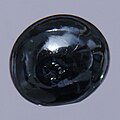Osmium
Osmium is a chemical element with the symbol Os and atomic number 76. It is a hard, brittle, blue-gray or blue-black transition metal in the platinum group that is found as a trace element in alloys, mostly in platinum ores. Osmium is the densest naturally occurring element, with a density of 22.59 g/cm3.
Characteristics[edit]
Osmium has a blue-gray tint and is the densest stable element; it is approximately twice as dense as lead. The high density of osmium is a consequence of the lanthanide contraction. People not familiar with osmium often mistake it for platinum. Osmium is a hard but brittle metal that remains lustrous even at high temperatures.
Applications[edit]
Osmium is used in high-strength alloys. Pen nibs, electrical contacts, and other applications that require extreme durability and hardness have been made from osmium alloys. Osmium tetroxide has been used in fingerprint detection and in staining fatty tissue for microscope slides. As a pure element, osmium is toxic and can cause lung damage if inhaled.
History[edit]
Osmium was discovered in 1803 by Smithson Tennant and William Hyde Wollaston in London, England. The discovery of osmium was followed shortly by the discovery of other platinum group metals. Osmium was named after the Greek word for "smell", because of the strong odor of its oxide.
Occurrence and production[edit]
Osmium is obtained commercially as a by-product from nickel and copper mining and processing. During electrorefining of copper and nickel, noble metals such as silver, gold and the platinum group metals, including osmium, settle to the bottom of the cell as anode mud, which forms the starting material for their extraction.
Precautions[edit]
Osmium tetroxide, OsO4, is highly toxic. Airborne low concentrations of osmium tetroxide vapor can cause lung congestion and skin or eye damage, and should therefore be used in a fume hood. Osmium powder can form the highly volatile and poisonous osmium tetroxide on exposure to air, and care should be taken to avoid contact with the skin and eyes.
See also[edit]
Ad. Transform your life with W8MD's Budget GLP-1 injections from $75


W8MD offers a medical weight loss program to lose weight in Philadelphia. Our physician-supervised medical weight loss provides:
- Weight loss injections in NYC (generic and brand names):
- Zepbound / Mounjaro, Wegovy / Ozempic, Saxenda
- Most insurances accepted or discounted self-pay rates. We will obtain insurance prior authorizations if needed.
- Generic GLP1 weight loss injections from $75 for the starting dose.
- Also offer prescription weight loss medications including Phentermine, Qsymia, Diethylpropion, Contrave etc.
NYC weight loss doctor appointmentsNYC weight loss doctor appointments
Start your NYC weight loss journey today at our NYC medical weight loss and Philadelphia medical weight loss clinics.
- Call 718-946-5500 to lose weight in NYC or for medical weight loss in Philadelphia 215-676-2334.
- Tags:NYC medical weight loss, Philadelphia lose weight Zepbound NYC, Budget GLP1 weight loss injections, Wegovy Philadelphia, Wegovy NYC, Philadelphia medical weight loss, Brookly weight loss and Wegovy NYC
|
WikiMD's Wellness Encyclopedia |
| Let Food Be Thy Medicine Medicine Thy Food - Hippocrates |
Medical Disclaimer: WikiMD is not a substitute for professional medical advice. The information on WikiMD is provided as an information resource only, may be incorrect, outdated or misleading, and is not to be used or relied on for any diagnostic or treatment purposes. Please consult your health care provider before making any healthcare decisions or for guidance about a specific medical condition. WikiMD expressly disclaims responsibility, and shall have no liability, for any damages, loss, injury, or liability whatsoever suffered as a result of your reliance on the information contained in this site. By visiting this site you agree to the foregoing terms and conditions, which may from time to time be changed or supplemented by WikiMD. If you do not agree to the foregoing terms and conditions, you should not enter or use this site. See full disclaimer.
Credits:Most images are courtesy of Wikimedia commons, and templates, categories Wikipedia, licensed under CC BY SA or similar.
Translate this page: - East Asian
中文,
日本,
한국어,
South Asian
हिन्दी,
தமிழ்,
తెలుగు,
Urdu,
ಕನ್ನಡ,
Southeast Asian
Indonesian,
Vietnamese,
Thai,
မြန်မာဘာသာ,
বাংলা
European
español,
Deutsch,
français,
Greek,
português do Brasil,
polski,
română,
русский,
Nederlands,
norsk,
svenska,
suomi,
Italian
Middle Eastern & African
عربى,
Turkish,
Persian,
Hebrew,
Afrikaans,
isiZulu,
Kiswahili,
Other
Bulgarian,
Hungarian,
Czech,
Swedish,
മലയാളം,
मराठी,
ਪੰਜਾਬੀ,
ગુજરાતી,
Portuguese,
Ukrainian








